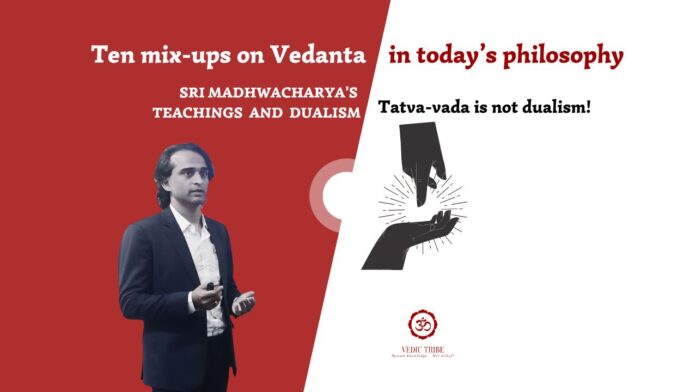Tattva-vada, not dualism!
In our previous article, we discussed how the original teachings of Vedanta are unavailable to commoners due to misinterpretations by western scholars and we listed ten mix-ups for clarification.
In this article we will discuss the first mix-up – Sri Madhwacharya’s teachings and dualism.
Sri Madhwacharya’s teachings has often been mistakenly labelled as “dualism.” This misnomer has led to a significant misrepresentation of his teachings to the common audience. To truly grasp the essence of his teachings, we must delve deeper into the concept of “Tattva-vada.”
What is dualism?
Dualism, in its broad sense, posits the existence of two fundamental and distinct realities. This could manifest as:
– Mind and matter
– Good and evil
– Light and darkness
The core idea is that these two realities are separate, often opposed, and irreducible to one another.
What is Tattva-vada?
A Reality-Based Approach: Tattva-vada, literally meaning “the contemplation of REALITY AS IT IS,” is a system that seeks to understand things as they truly are. It’s a meticulous analysis of existence, based on sensory perception, logical reasoning, and Vedic knowledge.
The Distinction of Entities: According to Tattva-vada, the universe is composed of distinct entities:
Matter – All material objects are distinct from one another.
Consciousness (Jeevatma) – Each individual soul is distinct.
Supreme Consciousness (Paramatma) – The supreme being is distinct from all other entities.
Why Not Dualism?
Two vs many: While dualism posits a division between two fundamental substances (often mind and matter), Tattva-vada goes beyond this simplistic dichotomy. It recognizes the multiplicity of entities and their inherent differences.
Idea of God: Dualism often neglects the role of a supreme being or the importance of scriptural authority. Many dualistic systems focus on the interaction or conflict between the two fundamental principles, without necessarily attributing their origin or governance to a higher power. In Tattva-vada, the idea of Parabrahma, the supreme being is central to the spiritual discussions.
The Misleading Term “Dvaita”
The term “dvaita” is frequently used to describe tattva-vada (even by traditional scholars). However, this term, which literally means “twoness” or “mistakenly considering one as two” is very misleading. It suggests a mere duality, whereas Tattva-vada encompasses a plurality of entities.
By understanding the true nature of Tattva-vada, we can appreciate the depth and richness of Sri Madhwacharya’s teachings. It’s a system that offers a comprehensive worldview, integrating rational inquiry with spiritual revelation.
Key take aways for you:
“Tattva-vada” and not dualism: While studying Vedanta, if you come across words like dualism or dvaita, replace them with “tattva-vada”. By using “tattva-vada,” we move away from a potentially misleading Western philosophical label and embrace a term that more accurately captures the core principles of Sri Madhwacharya.
Study tattva-vada: Understand what “tattva-vada” means and study Sri Madhwacharya’s teachings in the light of such knowledge. Instead of online search, consult a traditional Vedanta scholar who is well-versed in Sanskrit grammar, etymology…etc
In the next article, we will discuss the second mix-up – “Monism and Sri Shankaracharya’s teachings”.
Madhwesh K
Vedic Tribe

